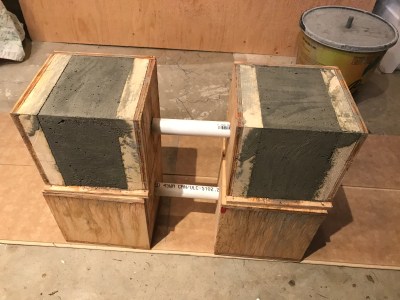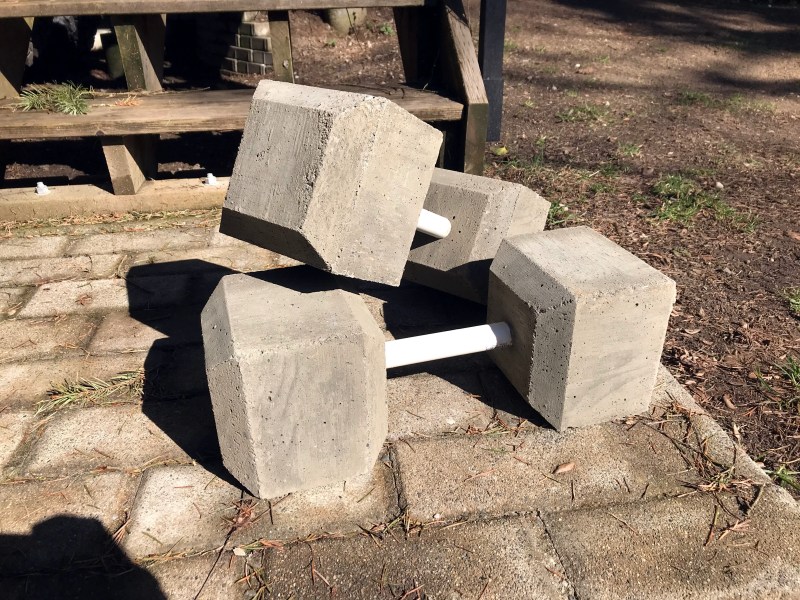Due to social distancing, gym rats throughout the world are turning everyday objects into exercise equipment to keep up the routine without actually hitting the gym. A particularly pleasing version of this are these concrete dumbbells whipped up by the unfortunately named hacker [ShitnamiTidalWave].
 If you happen to have half a bag of concrete — quick set or otherwise — out in the shed you can follow the lead on this one. But even if you’re not the kind of person who has “arm day” on your calendar (most of us here in the Hackaday bunker do not) this hack is still worth your time. Mold making is one of the uber-useful skills you should have in your hacker toolkit and [ShitnamiTidalWave] has done both an excellent job of building a mold, and of explaining the process.
If you happen to have half a bag of concrete — quick set or otherwise — out in the shed you can follow the lead on this one. But even if you’re not the kind of person who has “arm day” on your calendar (most of us here in the Hackaday bunker do not) this hack is still worth your time. Mold making is one of the uber-useful skills you should have in your hacker toolkit and [ShitnamiTidalWave] has done both an excellent job of building a mold, and of explaining the process.
Raw material for this one couldn’t be easier; each mold is made out of plywood, 2×4 stud, and nails, along with handles made of 3/4″ PVC pipe. The studs were ripped down and used to create the 45 degree chamfers at each edge. Mold-making veterans will tell you that release agent is a must and in this case rubbing the insides of the molds with wax made it a snap to pry the wooden forms off of the set concrete.
Concrete has a tendency to crack as it cures so if you’re casting large pieces like this touch-sensitive concrete countertop you might want to throw in some fiber reinforcement to the mix. If you’re keen on seeing some of the more impressive mold-making skills at work, check out how metal parts are cast from 3D-printed molds and how a master duplicates parts using silicone molds.
[via r/DIY]
















Reminds me of some dumbbells my uncle had back in the 80’s. They were made of a tough plastic exterior with a plug at one end. Being a curious kid, I popped the cap off of one and was surprised to find the thing filled to the brim with concrete!
That’s basically how commercial dumbbells are made today. A plastic shell filled with concrete mix.
Really? Dumbbells are not something on my weekly shopping list, but I have not seen plastic ones since the ones we bought in the 80s (and they’re crap) — only steel ones. But, then, I have not been in a Walmart in over a decade and have had no television for even longer, so they may well exist outside my observable universe.
Cool
Plastic dumbbells are quite common for sizes up to about 10-12 lbs. Plastic is more comfortable to hold and they don’t clink and clack like the metal weights with removable discs. The other variant is the steel dumbbell dipped in liquid rubber, but those are more expensive.
Another effect is that vinyl dumbbells filled with concrete are bigger than their steel counterparts, which gives the impression that you’re lifting a heavier weight. That’s a psychological thing. Solid steel is quite heavy and people aren’t accustomed to that, so they tend to pick up weights that are too heavy for them and that may lead to stress injury, or just giving up because the workout is proving too hard.
Also, when you drop a vinyl dumbbell, it doesn’t instantly gouge a hole in your floor.
Here’s an example of how the brand Eleiko does their dumbells (basically the world standard brand in weight/powerlifting)
https://www.eleiko.com/sv/p/eleiko-evo-dumbbells-fixed/1795#gs.26pwwj
Thats because you are in PRISON SIR!
Yep… even some of the lawn and garden care wheel weights are plastic with a concrete core.
They’re resourceful for sure if you’re budget conscious.
We had a weightlifting set back then with some iron bars (two short for dumbbells, one long one), and concrete-filled plastic weights of various sizes.
I just made my own with black iron pipe and concrete in windshield wiper fluid bottles. They’re about 35 lbs I think which is too much for biceps and not enough for anything else. Now I just need to make a pull-up bar and some smaller weights and a gym bench
3/4′ PVC pipe… Wouldn’t it be easier to just say 9 inches?
That’s a typo. It’s 3/4” otherwise known as 0.75 in, and it’s the nominal size of the PVC pipe (actual would be 1.050” outside diameter).
“Concrete has a tendency to crack s it cures so” is another typo.
Fixed!
You can also fill two cheap plastic balls with concrete for this purpose. This saves you the elaborate form and also gives you a stable cover.
My father, who was a gym teacher at the time, did this in the 70s.
That’s a great idea! Where could you find plastic balls? The only thing I could think of are the plastic balls that would come with the old bowling pin sets. Any other suggestions?
That construction would provide good incentive not to drop your weights. Or wear eye protection if you do.
Anyone else worried that the essentially unreinforced handle section might snap like a twig at some point when he’s lifting it? I would’ve put a piece of rebar through there.
In my experience PVC doesn’t fracture suddenly. It would bend and deform well before it broke apart (not preventing it but providing warning).
But I would be concerned with handles slipping out of the concrete. I would have put a pin through each end of pipe.
OLD, sun rotted PVC does… still, if the PVC was filled with concrete it would help. An old broom handle might work?
It depends on the PVC and the temperature. PVC has a narrow window where it’s ductile, yet doesn’t creep, which can be influenced by plasticizers and fillers to shift it towards cold or warm.
C’mon man. Pvc plastic as a handle?! At least use a piece of 3/4 black gas pipe lol
seriously.
Fill a five gallon bucket full of water and you’ve got yourself about 40lb of weight.
Not to mention it you change the amount of water you can change the amount of weight, more versitle.
5 liters of water and you have 5 kg of weight. Oh wait, international units make it too easy
or go metric and add 1000cc/1 litre of water for every 1 kilogram.
Well, it used to be that in most of the world, a gallon of water was a nice round 10 lbs, exactly. It’s those funny stunted little US gallons that are the weird weight.
The Pinewood Derby of weightlifting.
Both are available. Concrete is good for the “budget weights” for beginners, but once you start lifting heavy you really want to go for iron despite it costing about twice as much because concrete simply isn’t as dense and you’ll eventually run out of space on the bar.
TL;DR: You can find both, but will probably encounter more concrete at Wal Mart and more iron plates at specialized stores.
If you’re lifting heavy you already have your own iron.
The vinyl weights are filled with sand, not concrete.
I was planning to make garden tractor wheel weights with concrete using 5 gallon buckets and something not yet determined smaller, so can be plastic welded to, for the inner form. Then I wound up getting two free 80lbs ea wheel weights with a Ford YT16 that totaled $10 for since I felt bad getting for free and insisted at least take $10… so sidelined that concrete DIY project for now.
Am I the only one disappointed that given the headline this isn’t an article about building a DIY concrete pump?
:D
That’s kinda what i was hoping when I first clicked too.
Nope. The article even says, we’re not really the typical market for lifting weights. He’s right on that.
Used weights/dumbbells are practically free on craigslist.
Where have you been, there’s this outbreak that just came about, and everyone is sold out of them in stores so these things are like gold now…
I’ve been looking daily to try and find some weight lifting stuff. But even Craigslist, it’s difficult. My only option at the moment is to make my own equipment.